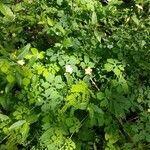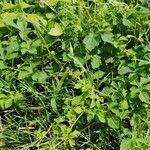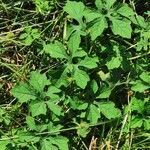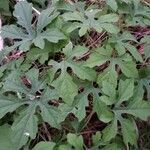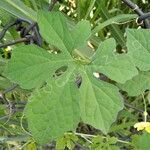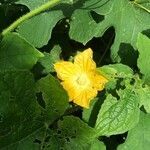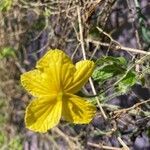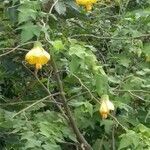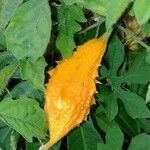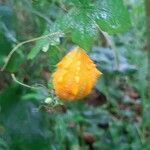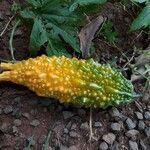Slender climber 2(-4) m long, annual, sparsely to densely hairy, partly glabrescent; monoecious. Leaves: petiole 1.5-5 cm long, without glands; blade usually deeply palmately 5-7(-9)-lobed, reniform or suborbicular in outline, 2.5-10 cm diam., glands minute, occasionally a few towards the blade base, lobes (ob)ovate, narrowed at base, margin sinuate-dentate, ± mucronate. Flowers solitary, ± hairy; petals yellow. Male flowers: stalk slender, with bract below middle; peduncle 0.5-3 cm long; bract reniform-suborbicular, 5-15 mm diam., apex ± mucronate, margin subentire; pedicel 20-60 mm long; receptacle-tube cup-shaped, 2-4 mm long and wide; sepals (narrowly) ovate-elliptic, 4-6 by 2-3 mm, acute, pale green; petals (narrowly) obovate, 10-20 by 7-15 mm, apex ± mucronate, basal scales 2; filaments 1.5-2 mm long, inserted in the throat of the receptacle-tube, anthers coherent; disc cup-shaped, c. 1.5 mm diameter. Female flowers: peduncle 0.5-5 cm long; bract 1-10 mm diam.; pedicel 10-50(-100) mm long; ovary 8-30 by 2-4 mm, narrowly rostrate, muricate-tuberculate; sepals narrow, oblong-lanceolate, 2-5 mm long; petals smaller than in male, 7-12 mm long; style c. 2 mm long; staminodes whitish, c. 0.5 mm long. Fruit ripening orange, (ovoid-)ellipsoid or narrowly ellipsoid, narrowed at the ends, at apex usually rostrate, 2-11(-40, cultivated) cm long, 2-4(-6) cm wide, soft, sharp or blunt tuberculate in 6-10 ridges, and usually soft spiny in between, splitting incompletely with 3 valves exposing orange-red pulp; fruitstalk 3.5-15 cm long. Seeds few (to numerous), pale brown, ± square, compressed, 8-11(-15) by 5-8 mm, sculptured, margin grooved.
Leaves simple, reniform. to suborbicular, 5-to 7-lobate to the middle or beyond, 3-6(-12) cm long and wide, the lobes oblong to spatulate, the apex obtuse and mucronate, the base cordate, the margin with obtuse to subacute teeth, submembranaceous to chartaceous, the upper surface minutely glandular, puberulent, at least on the veins; petiole 1-6 cm long, slender, striate; tendrils simple. Staminate flowers solitary, axillary; peduncle slender, 4-15 cm long, pubescent to puberulent, 5-lobate to near the middle, the lobes ovate lanceolate, 4-9 mm long, acute; corolla yellow, 5-lobate, the lobes oblong obovate, ca. 1 cm long, the apex obtuse to emarginate, pubescent on the outer surface and on the upper edge of the inner with both simple and glandular hairs, prominently 5-to 9-nerved; stamens 3, the filaments free, 2-3 mm long, the anthers 3, thecas flexu-ous, connate, forming an irregular head, ultimately free. Pistillate flowers soli-tary, axillary; peduncle 5-10 cm long, slender, pubescent, bearing a minute sub-basal bract; calyx and corolla similar to those of the staminate flower; ovary fusiform, rostrate, tuberculate, pubescent, the styles 3, connate, 2-3 mm long, the stigmas 3, each 2-lobate. Fruit bright orange red, ovoid to fusiform, long rostrate, 4-8 cm long, 2-4 cm in diameter, the surface with obtuse to acute tubercles, glabrate, 3-carpellate, 3-valvate, the valves curling back to expose the bright red aril surrounding each seed; seeds numerous in each carpel, oblong, 8-10 mm long, 4-6 mm wide, moderately compressed, slightly 3-toothed at both ends, the testa rugulose.
Perennial herb.Stems prostrate or scandent to 5 m, sparsely to densely crispate-pubescent or villous, especially at nodes. Leaf-lamina 1-10 x 1-12·5 cm, broadly ovate to orbicular in outline, cordate, narrowly decurrent on to petiole, punctate and sparsely pubescent to densely villous on veins beneath, sparsely hirsute especially on veins above, deeply palmately 3-7-lobed, lobes variously sinuate-dentate or lobulate, acute to retuse, apiculate. Petiole 0·5-7 cm long. Tendrils simple. Flowers monoecious, solitary. Male flowers: peduncle 0·3-5 cm long; bract 2-17 mm long, broadly ovate or reniform, sessile, cordate, amplexicaul, obtuse or retuse, apiculate, green; pedicel 2-9·5 cm long. Receptacle-tube 1-5 mm long; lobes 3-7 mm long, ovate-lanceolate. Petals 1·0-2·5 cm long, pale to deep yellow, ovate to obovate. Female flowers: peduncle 0·2-5 cm long; bract 1-12 mm long; pedicel 1-10 cm long; ovary 8-11(30) × 2-4 mm, ovoid-rostrate to fusiform, ridged, pilose on ridges, tuberculate; receptacle-tube 1-3 mm long, lobes 2-5 mm long, lanceolate; petals 0·7-1·2 cm long. Fruit 2·5-4·8(11) × 1·5-2·3(4) cm, ovoid-rostrate or ellipsoid, longitudinally ribbed and tuberculate, bright orange-red, dehiscent into 3 valves; fruit-stalk 3·4-15 cm long. Seeds 8-11 x 4·5-8 x 2-3·5 mm, enveloped in sticky red pulp, ovate-elliptic to oblong in outline; faces flattened, sculptured, with sinuate edges; margins grooved.
Plants annual, scandent, many branched; stem and branches pubescent. Tendrils to 20 cm, puberulent, simple. Petiole slender, 4-6 cm, white pubescent at first, glabrescent; leaf blade ovate-reniform or suborbicular, 4-12 × 4-12 cm, membranous, puberulent on veins, 5-7-partite; lobes ovate-oblong, veins palmate, margin crenate or irregularly lobed, apex obtuse or acute; sinus semicircular. Plants monoecious. Male flowers solitary in axils of leaves; pedicel slender, 3-7 cm, puberulent, with a median bract; bract reniform or orbicular, 5-15 mm, entire, both surfaces puberulent; calyx segments ovate-lanceolate, 4-6 × 2-3 mm, white pubescent, apex acute; corolla yellow; segments obovate, 15-20 × 8-12 mm, pubescent, obtuse or retuse; stamens 3, free; anther cells conduplicate. Female flowers solitary; pedicel 10-12 cm, with a bract at base; ovary fusiform, densely verrucose; stigmas expanded, 2-lobed. Fruit orange when mature, fusiform or cylindric, 10-20 cm, verrucose, 3-valved from apex. Seeds numerous, oblong, 15-20 × 10-15 cm. Fl. and fr. May-Oct.
Monoecious annual herb, pubescent or glabrescent. Leaves broadly ovate to sub-orbicular, cordate at base; lamina 4–10 cm long, 4–8 cm wide, cordate, deeply 5-lobed; lobes ovate, acute, dentate, glabrescent or pubescent beneath; petiole 3–5 cm long. Male flowers: flower-scape 4–80 mm long, bracteate towards base or near middle; bract sub-orbicular, 3–20 mm long, mucronate, green; hypanthium 2–4 mm long; calyx-lobes lanceolate, 4–6 mm long; petals obovate to spathulate, 10–12 mm long. Female flowers: flower-scape 2–50 mm long, bract as for males; ovary ovoid, attenuate, 8–30 mm long; stigmas papillate. Fruit ovoid to ellipsoidal, attenuate, 3–12 cm long, ornamented with short longitudinal ridges and warts, orange-red. Seeds few to many, ovate, 8–16 mm long, pale brown, the margin slightly undulate, granular.
A pumpkin family plant. It is a slender annual climber with flowers of both sexes on the one plant. It has simple tendrils and vines can be 4 m long. It has bright green lobed leaves. The leaves are 5 to 12 cm long on thin leaf stalks 3-10 cm long. The flowers have 5 petals, are small, yellow and with a sweet smell. Fruit are green when young and orange when ripe. The fruit have a lumpy appearance, with ridges along its length and when fully ripe burst open. It has bright red covering on the seeds inside. The seeds are 10-16 mm long and 7 to 10 mm wide and pale brown. Considerable variation in the fruit occurs between varieties.
Prostrate or scandent herb. Tendrils simple. Stems and petioles concolorous, uniformly green. Leaf lamina deeply palmately 3-7-lobed usually to middle or beyond; lobes narrowed towards base, rhombic, elliptic or obovate in outline, ± sinuate-lobulate. Male flowers solitary, pedicel 20-95 mm long; peduncle free from petiole of subtending leaf. Ovary and fruit with longitudinal rows of larger tubercles and with smaller interstitial tubercles; fruit stalk 34-122 mm long. Flowers pale to deep yellow.
Leaf-lamina 1–10 × 1–12·5 cm., broadly ovate to orbicular in outline, cordate, narrowly decurrent on to petiole, punctate and sparsely pubescent to densely villous on veins beneath, sparsely hirsute especially on veins above, deeply palmately 3–7-lobed, lobes variously sinuate-dentate or lobulate, acute to retuse, apiculate.
male flowers: peduncle 0·3–5 cm. long; bract 2–17 mm. long, broadly ovate or reniform, sessile, cordate, amplexicaul, obtuse or retuse, apiculate, green; pedicel 2–9·5 cm. long. Receptacle-tube 1–5 mm. long; lobes 3–7 mm. long, ovate-lanceolate. Petals 1·0–2·5 cm. long, pale to deep yellow, ovate to obovate.
Female flowers: peduncle 0·2–5 cm. long; bract 1–12 mm. long; pedicel 1–10 cm. long; ovary 8–11(30) × 2–4 mm., ovoid-rostrate to fusi-form, ridged, pilose on ridges, tuberculate; receptacle-tube 1–3 mm. long, lobes 2–5 mm. long, lanceolate; petals 0·7–1·2 cm. long.
Fruit 2·5–4·8(11) × 1·5–2·3(4) cm., ovoid-rostrate or ellipsoid, longitudinally ribbed and tuberculate, bright orange-red, dehiscent into 3 valves; fruit-stalk 3·4–15 cm. long.
Seeds 8–11 × 4·5–8 × 2–3·5 mm., enveloped in sticky red pulp, ovate-elliptic to oblong in outline; faces flattened, sculptured, with sinuate edges; margins grooved.
Stems prostrate or scandent to 5 m., sparsely to densely crispate-pubescent or villous, especially at nodes.
Fruit ripening orange, 2–3 in. long, bursting in 3 valves to expose the carmine red seeds
Flowers monoecious, solitary.
Climber, flowers yellow
Petiole 0·5–7 cm. long.
Tendrils simple.

